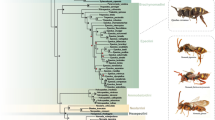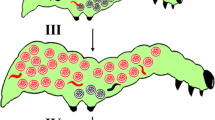Abstract
STUDIES of the role of haplodiploidy in the evolution of eusociality have been limited to the Hymenoptera, the only insects known to exhibit both reproductive castes and the haplodiploid genetic system1. Because aculeate Hymenoptera share many other traits that may affect sociality, such as provisioning at nests, powerful flight, mandibulate mouthparts, and stings, it has been difficult to separate the effects of haplodiploidy from other characteristics of this taxonomic group2'3. Here I report the presence of eusociality in a second haplodiploid insect taxon, the order Thysanoptera. Sub-fertile 'soldier' adults of the Australian gall thrips Oncothrips tepperi Karny and O. habrus Mound defend the gall containing their mother and siblings from invasion and takeover by inquiline thrips species and other insect invaders. Australian gall thrips provide remarkable new opportunities for analysing the causes of the evolution of eusociality.
This is a preview of subscription content, access via your institution
Access options
Subscribe to this journal
Receive 51 print issues and online access
$199.00 per year
only $3.90 per issue
Buy this article
- Purchase on Springer Link
- Instant access to full article PDF
Prices may be subject to local taxes which are calculated during checkout
Similar content being viewed by others
References
Wilson, E. O. The Insect Societies (Belknap, Harvard Univ. Press, Cambridge, 1971).
Andersson, M. A. Rev. ecol. Syst. 15, 165–189 (1984).
Alexander, R. D., Noonan, K. & Crespi, B. J. in The Biology of the Naked Mole-Rat (eds Sherman, P., Jarvis, J. U. M. & Alexander, R. D.) 3–44 (Princeton Univ. Press, New Jersey, 1991).
Crespi, B. J. J. nat. Hist. (in the press).
Mound, L. A. Bull. Br. Mus. nat. Hist. (Ent.) 25, 389–466 (1971).
Mound, L. A. Ent. Mon. Mag. 105, 159–162 (1970).
Aoki, S. in Animal Societies: Theories and Facts (eds Itô, Y., Brown, J. L. & Kikkawa, J.) 53–65 (Japan Sci. Soc. Tokyo, 1987).
Cruz, Y. P. Nature 294, 446–447 (1981).
Crespi, B. J. in Evolution and Diversity of Sex Ratio in Insects and Mites (eds Wrensch, D. & Ebbert, M.) (Chapman and Hall, New York, in the press).
Hamilton, W. D. J. theor. Biol. 7, 1–52 (1964).
Trivers, R. L. & Hare, H. Science 191, 249–263 (1976).
Author information
Authors and Affiliations
Rights and permissions
About this article
Cite this article
Crespi, B. Eusociality in Australian gall thrips. Nature 359, 724–726 (1992). https://doi.org/10.1038/359724a0
Received:
Accepted:
Issue Date:
DOI: https://doi.org/10.1038/359724a0
This article is cited by
-
Endosymbionts moderate constrained sex allocation in a haplodiploid thrips species in a temperature-sensitive way
Heredity (2022)
-
Benefits of insect colours: a review from social insect studies
Oecologia (2020)
-
Neotropical Melyroidea group cockroaches reveal various degrees of (eu)sociality
The Science of Nature (2020)
-
The effects of disturbance threat on leaf-cutting ant colonies: a laboratory study
Insectes Sociaux (2017)
-
Variation in nesting behavior of eight species of spider mites, Stigmaeopsis having sociality
The Science of Nature (2016)
Comments
By submitting a comment you agree to abide by our Terms and Community Guidelines. If you find something abusive or that does not comply with our terms or guidelines please flag it as inappropriate.



